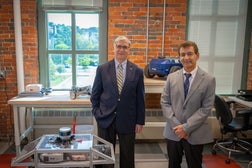Technology, skills (or lack of them) weigh on region's manufacturers

Manufacturing continues to struggle in Central Massachusetts, with both national and regional factors to blame.
The national manufacturing discussion has turned to reshoring, bringing back manufacturing jobs to this country through more reliance on automation, coupled with rising wages in developing nations where manufacturers have relocated. Closer to home, the focus continues to be on finding qualified workers to facilitate expansion, as the industry continues to grow slowly.
Like prior years, 2015 will continue to be a building year for manufacturing in the state.
Here are five things to watch in 2015 in manufacturing, especially the technology that facilitates it:
1. 3D printing will be put to the test
While 3D printing may grab headlines, it's not yet ready for prime time. 3D printing may allow for new, innovative approaches, but the products it creates have yet to be stress-proven by any but the largest companies, such as Raytheon, according to Torbjorn Bergstrom, the director of the Haas Technical Education Center at Worcester Polytechnic Institute, who also manages the school's manufacturing laboratories.
"(Additive manufacturing) is not really fully developed yet, especially when it gets into printing metal parts," he said explaining that the technology still has a way to go toward making durable goods. "It's still really a prototyping tool and for customizing things."
But in the coming year, more manufacturers will experiment to test the capabilities of 3D printed parts, which will ultimately allow the technology to go mainstream. WPI will be getting into the action with a new center devoted to stress-testing 3D parts.
"We are building a center where we are going to be 3D printing all day long so we can bring them to a lab next door and break them," Bergstrom said.
2. Workforce shortfalls continue to stifle growth
The biggest hurdle to manufacturing growth in Central Massachusetts 2015 will be the continuing lack of a suitable workforce. According to Jack Healy, director of operations at the Massachusetts Manufacturing Extension Partnership (MassMEP) in Worcester, getting qualified workers will continue to be the key defining factor for the region's manufacturers.
"That is still an issue and is going to be an issue," Healy said.
Bergstrom added: "I have seen companies buy machines and then sell them because they could not find an operator."
One solution for the area's workforce woes comes in the form of relatively inexpensive, online training, said Bergstrom, who helps run a retraining program at WPI.
"The trend is going to be virtual training and online training," Bergstrom said.
3. Manufacturers tap into the innovation economy
With the continued emphasis on the innovation economy in Massachusetts, specific manufacturing efforts will play an important role. To bring a product to market, someone needs to make it, Bergstrom said, and the process relies strongly on small, innovative manufacturing companies.
"I think it has to," Bergstrom said. "Almost all of the manufacturing companies in Massachusetts are small manufacturing companies."
Central Massachusetts is an ideal place for startup or focused extensions of current manufacturing efforts, he added. Portions of expansive manufacturing buildings can easily be adapted toward a very specific focus.
4. The Internet of Things ties machines together
The machines aren't rising up against their makers, but they will begin talking to each other in 2015. The "Internet of Things" describes smart machines that can let their operators know they're running low on coolant or can receive an order remotely and begin producing it automatically.
"It's really having machines talk to machines," Healy said.
5. The cloud continues to grow
While cloud storage was all the rage in 2014, the use of cloud computing, which allows for online access to computer services, is positioned to grow in 2015. The global market for these services is expected to grow at a compound annual growth rate of 17.6 percent from 2014 to 2020 to become a $555 billion market, according to a study by Allied Market Research.
The fourth-quarter results for Adobe Systems, of Mountain View, Calif., show how large the payoff can be for an individual company. Adobe reported more than 3.4 million paid subscribers to its Creative Cloud business, which hosts its software online through a subscription service. That's up from 644,000 the previous quarter.
"We expect to grow total subscriptions by approximately 70 percent year over year and exit the year with approximately 5.9 million subscriptions," Mike Saviage, Adobe's vice president of investor relations said in an earnings call of the expected rise in subscriptions.













0 Comments